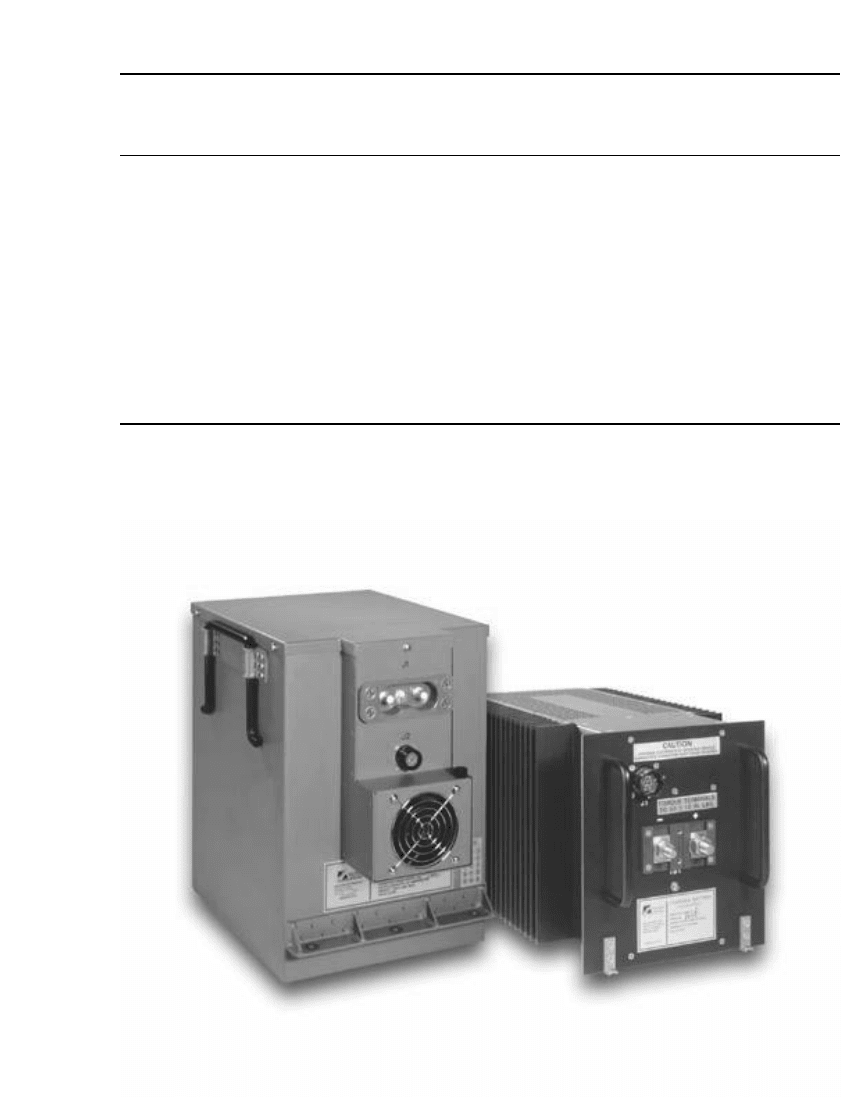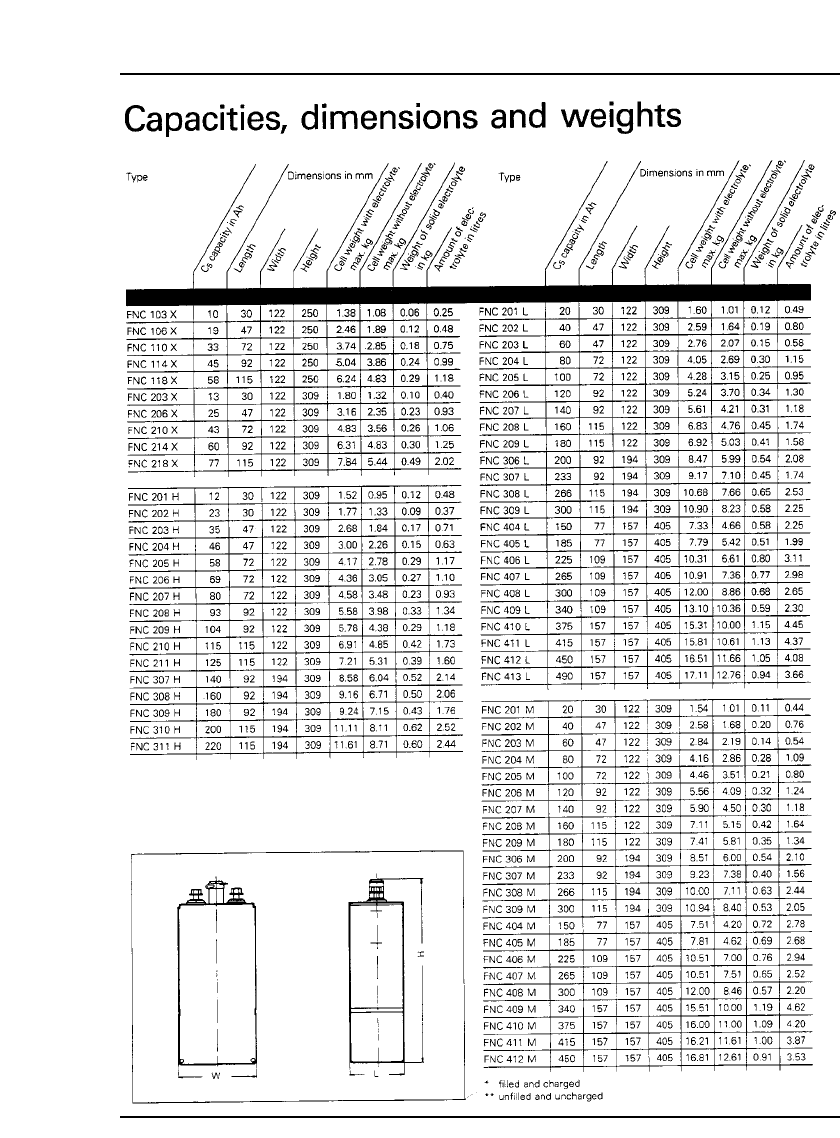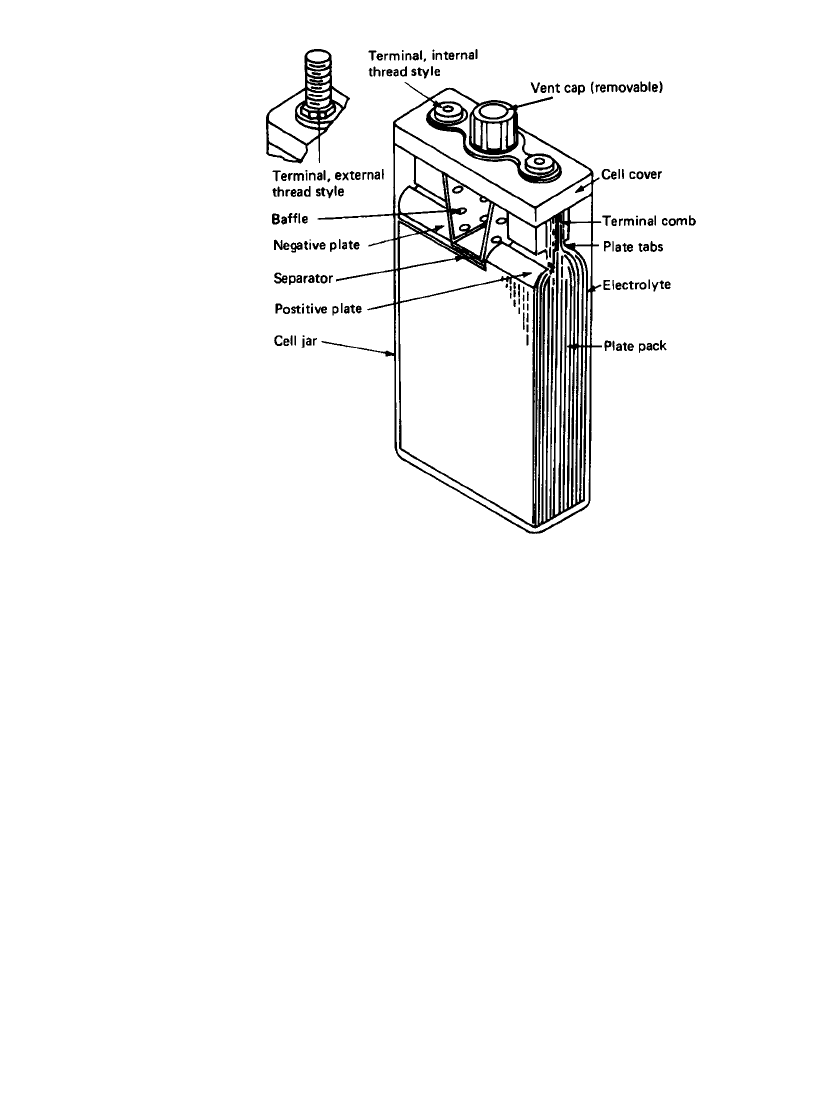Linden D., Reddy T.B. (eds.) Handbook of batteries
Подождите немного. Документ загружается.


26.26 CHAPTER TWENTY-SIX
TABLE 26.5 Characteristics of Typical Fiber Nickel Cadmium Batteries
Battery
type
Rated
capacity
(Ah)
Resistance m
⍀
(fully charged)
25
⬚C
Weight
(kg)
Length
(mm)
Width
(mm)
Height
(mm)
X7 6.5 2.6 0.28 57 24 105
X15 15 1.4 0.57 61 29 178
X18 17 1.1 0.73 67 36 147
X26 26 0.8 1.13 115 25 168
X44 44 0.6 1.72 115 41 168
X55 55 0.5 2.05 115 54 166
X68 68 0.4 2.59 115 59 166
X81 81 0.5 3.13 115 54 224
XX23 23 0.7 1.13 115 25 168
XX40 40 0.4 1.72 115 41 168
XX47 47 .035 2.05 115 54 166
H8 8 0.29 57 24 100
H85 78 2.45 115 59 166
Source: Courtesy Acme Electric Corp.
FIGURE 26.22 FNC airborne battery system. Battery (left); charger (right). 28 V, 47 Ah battery.

INDUSTRIAL AND AEROSPACE NICKEL-CADMIUM BATTERIES 26.27
TABLE 26.6 Standard Line of Sealed FNC Batteries in X, H, M and L Models
Source: Hoppecke Batterien.

26.28 CHAPTER TWENTY-SIX
26.8 APPLICATIONS
Because of their favorable electrical properties, excellent reliability, low maintenance, rugged
design, and long life, nickel-cadmium batteries are used in a large variety of applications,
as indicated in Table 26.4. Most of these are of an industrial nature, but this type of battery
is also used in many commercial, military and space applications.
The nickel-cadmium battery was originally developed for traction applications, and since
the early years of this century, it has been used extensively in railroad applications. Today
the nickel-cadmium battery is the system of choice in a variety of railroad and mass-transit
installations around the world. Approximately 40% of all industrial nickel-cadmium batteries
produced are used in train lighting and air-conditioning for rail cars, emergency and standby
systems such as emergency brakes, door openers, and lighting in mass-transit and subway
cars, diesel-engine cranking in locomotives and commuter cars, railroad signaling, commu-
nication along tracks, as well as standby power in rail stations and traffic control systems.
The pocket-plate battery has traditionally dominated this market segment, but in recent years,
with demands for higher energy per unit weight and volume, plastic-bonded and fiber-plate
batteries have penetrated this market, particularly for high-speed trains, mass-transit cars,
subway cars, and light rail vehicles. Where ruggedness and long durability are the main
requirements, the pocket-plate battery still maintains its position.
In stationary applications where reliability is a must, nickel-cadmium batteries are used
in standby and emergency installations where life and great economic values would be
endangered by a power failure. Examples of such installations are emergency power in
hospital operating theaters, standby power for all vital functions on off-shore oil rigs, un-
interruptible power supplies (UPSs) for large computer systems in banks and insurance com-
panies, standby power in process industries, and emergency lighting and landing systems in
airports.
The nickel-cadmium battery is also used in power-generating stations and power distri-
bution networks where power supplies must not break down. The batteries are used in switch-
gear applications and for control and monitoring functions. In centralized emergency lighting
systems in hospitals, public buildings, sports arenas, and schools, nickel-cadmium batteries
are often specified in building codes and by consultants in many industrialized countries.
In case of failure of the primary power supply, diesel generators or gas turbines are
installed to take over the power supply. For reliable and fast-acting start-up of these engines
nickel-cadmium batteries have proven to be the best emergency power source.
In portable applications were batteries are exposed to temperature extremes or rough
handling, nickel-cadmium batteries are used for signal lamps, hand lamps, search lights, and
portable instruments. Vented spillproof batteries are used in large devices, whereas sealed
nickel-cadmium batteries dominate the smaller ones (see Chap. 27).
The industrial battery market is dominated by the lead-acid battery, and the nickel-
cadmium battery is a niche-market product. The reason for this is the higher capital cost for
nickel-cadmium batteries compared to lead-acid batteries. Where only energy is required,
the lead-acid battery is the least expensive, as its cost per Watt-hour is lower than that for
nickel-cadmium batteries. However, in cost per Watt or life cycle cost, nickel-cadmium bat-
teries can compete with lead-acid batteries due to much better high-rate performance and
longer life combined with low maintenance costs. A typical example is locomotive diesel-
engine cranking, where a nickel-cadmium battery with only one-third of the Ampere-hour
capacity and a life four times that of the lead-acid battery can do the job. In applications
with short-duration discharges—standby and emergency equipment are usually used for less
than a half-hour—the rated capacity of a battery is of little importance. The size of the
battery is chiefly determined by the power need. The nickel-cadmium battery is unmatched
in industrial applications when reliability and durability are considered in a life-cycle cost
calculation.

INDUSTRIAL AND AEROSPACE NICKEL-CADMIUM BATTERIES 26.29
Fiber nickel-cadmium batteries of the ultra high-rate (XX) and high-rate (X) design are
employed primarily in aircraft, military and space applications. They have been used for the
Boeing 777 main and APU batteries, for the MacDonald-Douglas (now Boeing) MD-90
APU and emergency position batteries and for the Apache helicopter main battery. They
have also been employed as the training battery for a portable missile system, and are
qualified for use in a Low Earth Orbit (LEO) satellite scheduled for launch in 2002 on a
two-year mission.
Because of the variety of applications for nickel-cadmium batteries, it is important to
select the best technology for the application. The characteristics are somewhat different for
the three technologies available today for industrial use.
The pocket-plate battery has the lowest cost of the three technologies and is known for
high reliability and fail-safe operation. However, the energy and power density limit its use
in some areas. The fiber plate battery has lower internal resistance than the pocket-plate
battery and is also available in ultra-high, high-, medium- and low-rate cells. Where very
high energy and power density are required, the plastic-bonded plate may be the choice. The
plastic-bonded and fiber plate batteries are the only technologies possible for use in auto-
mated guided vehicles (AGVs). They have also cost and performance advantages in some
traditional pocket-plate battery applications such as engine cranking, switchgear, and unin-
terruptible power supplies (UPSs) where only very short duration discharge is required.
BIBLIOGRAPHY
General:
Barak, M. (ed.) Electrochemical Power Sources, Peter Peregrinus, London, 1980.
Falk, S. U., and A. J. Salkind, Alkaline Storage Batteries, Wiley, New York, 1969.
Jacksch, H.-D., Batterie Lexikon, pp. 348–394, Pflaum Verlag, Munich (1993).
Kinzelbach, R., Stahlakkumulatoren, Varta, Hannover, Germany, 1968.
Miyake, Y., and A. Kozawa, Rechargeable Batteries in Japan, JEC Press, Cleveland, Ohio, 1977.
Plastic-Bonded Electrode Technology:
McRae, B., and D. Nary, Proc. of the 38th Power Sources Conf., pp. 123–126 (1998).
FNC Technology:
Anderman M., C. Baker, and F. Cohen, Proc. of the 32nd Intersociety Energy Conversion Conf., Vol. 1,
p. 97465 (1997).
Baker, C., Proceedings of the SAE Power Systems Conference, Williamsbury, VA (1997). See Advanced
Battery Technology, April, 1997.
Baker C., and M. Barekatien, Proc. SAE Power Systems Conf., San Diego, CA, Oct 31–Nov. 2, 2000.
FNC Vented Nickel-Cadmium Batteries, Hoppecke Batterien.

27.1
TABLE 27.1 Major Advantages and Disadvantages of Vented Sintered-Plate Nickel-Cadmium
Batteries
Advantages Disadvantages
Flat discharge profile Higher cost
Higher energy density (50% greater than pocket
plate)
Memory effect (voltage depression)
Superior high-rate and low-temperature
performance
Temperature controlled charging system required
to enhance life
Excellent long-term storage
Good capacity retention; capacity can be restored
by recharge
CHAPTER 27
VENTED SINTERED-PLATE NICKEL-
CADMIUM BATTERIES
John M. Evjen and Arthur J. Catotti
Revised by: R. David Lucero, David F. Pickett Jr.,
and Timothy M. Kulin
27.1 GENERAL CHARACTERISTICS
The sintered-plate nickel-cadmium battery is a mature development of the nickel-cadmium
system, having a higher energy density, up to 50% greater than its predecessor, the pocket-
type construction. The sintered plate can be constructed in a much thinner form than the
pocket plate, and the cell has a much lower internal resistance and gives superior high-rate
and low-temperature performance. A flat discharge curve is characteristic of the battery, and
its performance is less sensitive than other battery systems to changes in discharge load and
temperature. The sintered-plate battery has most of the favorable characteristics of the pocket-
type battery, although it is generally more expensive. It is electrically and mechanically
rugged, is very reliable, requires little maintenance, can be stored for long periods of time
in a charged or uncharged condition, and has good charge retention. Batteries losing capacity
through self-discharge can be restored to full service with a normal charge. The major ad-
vantages and disadvantages of this battery type are given in Table 27.1.

27.2 CHAPTER TWENTY-SEVEN
For these reasons, vented sintered-plate nickel-cadmium batteries are used in applications
requiring high-power discharge service such as aircraft turbine engine and diesel engine
starting as well as other mobile and military equipment. The battery provides outstanding
performance where high peak power and fast recharging are required. In many applications
the vented sintered-plate battery is used because it leads to a reduction in size, weight and
maintenance as compared with other battery systems. This is particularly true in systems
subject to low-temperature operation. The rise in terminal voltage of the vented cell at the
end of charge also provides a useful characteristic for controlling the charge.
27.2 CHEMISTRY
Vented sintered-plate nickel-cadmium cells, in the discharged state, consist of flat positive
nickel hydroxide and negative cadmium hydroxide plates, separated by materials that act as
a gas barrier and electrical separator. The electrolyte, normally a 31% potassium hydroxide
solution completely covers the plates and separators: for this reason vented cells are referred
to as ‘‘flooded cells.’’
In the sintered-plate design, the active materials are held within the pores of a sintered-
nickel structure. Nickel hydroxide with 3% to 10% cobalt hydroxide is the active material
of the positive plate while cadmium hydroxide is the active material of the negative plate.
The electrochemistry of the charge and discharge of the positive electrode is quite com-
plex and not well understood,
1
especially, the role that cobalt plays in the active material.
2
For simplicity, lets consider the role of nickel hydroxide in the charge-discharge reaction.
During charge the nickel hydroxide in the positive electrode is oxidized to nickel oxy-
hydroxide (NiOOH) and higher valence states of nickel. Potassium and water are also in-
corporated into the active material as potassium hydroxide according to the following equa-
tion:
3
⫹⫺
—
Ni(OH) ⫹ xK ⫹ (1 ⫹ x)OH NiOOH 䡠 xKOH 䡠 (H O) ⫹ e
—
22
The fraction of potassium that is bonded into the nickel oxyhydroxide lattice is represented
by x. The value is small (much less than 1.0) and varies according to manufacturing process.
The cadmium hydroxide in the negative electrode is reduced to metallic cadmium during
charge:
⫺
—
Cd(OH) ⫹ 2e Cd ⫹ 2OH
—
2
The overall charge-discharge reaction is thus
charge
—
2Ni(OH) ⫹ 2xKOH ⫹ Cd(OH) 2NiOOH 䡠 xKOH 䡠 (H O) ⫹ Cd
—
22 2
discharge
According to the above equation, one might think that the change in the electrolyte
concentration might offer a means of state-of-charge determination by measuring the specific
gravity of the electrolyte. Unfortunately, the complication of potassium in the active material,
accumulation of carbonates, along with the large volume of electrolyte makes this type of
measurement unreliable and impractical.
The positive electrode does not accept charge, and convert nickel hydroxide to nickel
oxyhydroxide, at the thermodynamically reversible potential.
3
In fact, with a low enough
charge rate, gassing according to the equation below occurs:
⫺
4OH → 2H O ⫹ O ⫹ 4e
22
If the rate is increased appreciably, this will result in an oxygen overvoltage sufficiently
high to allow the preferred conversion of the nickel hydroxide to the nickel oxyhydroxide
instead of oxygen gassing. However, when about 80% conversion of nickel hydroxide to

VENTED SINTERED-PLATE NICKEL-CADMIUM BATTERIES 27.3
nickel oxyhydroxide is achieved, the competing oxygen generating reaction occurs gradually
and remains until 100% state-of-charge is achieved, then the only reaction occurring is
oxygen evolution.
The negative electrode accepts charge until it is essentially 100% charged, at which time
the favored reaction is hydrogen gassing as shown in the following equation
⫺
2H O ⫹ 2e → H ⫹ 2OH
22
The hydrogen gassing reaction, with a C/ 10 charge rate, occurs at a cell voltage close to
1600 millivolts as shown in Fig. 27.1.
The hydrogen overvoltage on the cadmium electrode is quite high, about 110 mV at the
C/ 10 rate. Consequently there is a sharp rise in voltage as the negative electrode goes into
overcharge. This rise in voltage is used in various charging schemes to control or terminate
charging.
During overcharge, all the current is used to electrolyze water to hydrogen and oxygen
as shown in the overall reaction
2H O
→ 2H ⫹ O
222
This overcharge reaction consumes water and thereby decreases the level of electrolyte in
the cell. The water loss can be limited by controlling the amount of overcharge so as to
maximize the interval between needed water replenishments.
Cells are constructed with 50% excess capacity in the negative electrodes and thus are
positive limited.
FIGURE 27.1 Constant-current charge voltage of vented sintered-plate
nickel-cadmium cell, C / 10 charge rate.
27.3 CONSTRUCTION
Vented cells are designed so that both electrodes reach full charge at about the same time.
The positive electrode, as noted, will begin to evolve oxygen before it is fully charged. If
this gas is allowed to reach the negative electrode due to failure of the gas barrier, it will
recombine and generate heat. This will not only prevent the negative from reaching a full
state of charge, but it will also result in reduced voltage due to depolarization of the cadmium
electrode. To maintain the fullest capability, adequate precautions must be taken to prevent
oxygen recombination at the negative plate. This is accomplished by providing a gas barrier
between the positive and negative plates and by flooding the plates with excess electrolyte.
Figure 27.2 shows details of a typical vented sintered-plate nickel-cadmium cell.

27.4 CHAPTER TWENTY-SEVEN
FIGURE 27.2 Cross section of vented sintered-plate nickel-
cadmium cell.
27.3.1 Plates and Processes
A variety of plate formulations are used in vented, sintered nickel-cadmium cells produced
by different manufacturers. The plates differ according to the nature of the substrate, method
of sintering, impregnation process, formation and termination techniques. The predominate
plate fabrication process used for vented sintered plate over the years has been described by
Fleischer.
4
There are several reviews on electrode fabrication processes that have been used
in flooded vented cells.
3,5,6
Substrate. The substrate serves as a mechanical support for the sintered structure and as a
current collector for the electrochemical reactions which occur throughout the porous sintered
portion of the plate. It also provides mechanical strength and continuity during the manu-
facturing processes. Two types of substrate are typically used: (1) perforated nickel-plated
steel or pure nickel strip in continuous lengths, and (2) woven screens of nickel or nickel-
clad steel wire. A common perforated type may be 0.1 mm thick with 2-mm holes and a
void area of about 40%. A typical screen may use 0.18-mm-diameter wire with 1.0-mm
openings.
Plaque. The sintered structure before impregnation is generally referred to as ‘‘plaque.’’ It
usually has a porosity of 80 to 85% and ranges in thickness from 0.40 to 1.0 mm. Two
generic sintering processes are used: (1) the slurry coating process and (2) the dry-powder
process. Both processes employ special low-density battery grades of carbonyl nickel powder.

VENTED SINTERED-PLATE NICKEL-CADMIUM BATTERIES 27.5
In the slurry coating process, the nickel powder is suspended in a viscous, aqueous so-
lution containing a low percentage of a thixotropic agent. The nickel-plated strip with the
desired perforated pattern is pulled through the suspension. The thickness is controlled by
passing it through doctor blades, while wiping the edges free of slurry. The continuous strip
is then dried before sintering in a reducing atmosphere at about 1000
⬚C.
The dry-powder processes generally employ wire screen precut to the so-called master
plaque dimension. The screens are placed in molds with loose powder on each side. They
are then typically sintered in a belt furnace in a reducing atmosphere at 800 to 1000
⬚C.
Impregnation. A review of various impregnation processes, used to load the porous sin-
tered structure of the positive with nickel hydroxide and of the negative with cadmium
hydroxide, has been given by Pickett.
6
The plaque is impregnated with a concentrated so-
lution of nitrate that is then converted to hydroxide by chemical precipitation
4
or electro-
chemical precipitation.
7,8,9
The most widely used process for vented cells involves a chemical
precipitation, and with minor variations, follows, in principle, the process described in 1948.
4
The plaque is impregnated with a concentrated solution of the nitrate, briefly rinsed, and the
nitrate salts are precipitated as hydroxide with caustic. Following the addition of caustic the
plaque is made cathodic. This is called polarization. The polarization cycle usually consists
of a high current charge (C rate or higher) for approximately one hour. The plaque is then
rinsed and this sequence of steps is repeated a number of times so as to fill about 40 to 60%
of the sintered pore volume (or until a targeted weight gain is achieved).
Plate Formation. Following impregnation, the plates are mechanically brushed and elec-
trochemically cleaned and formed by charging and discharging the electrode. In the master-
plaque process they are formed against inert counterelectrodes (typically stainless steel or
nickel) and can be performed in a loose pack or tight pack configuration. Formation is
essential for properly converting hydroxide into the pores of the sinter structure, as well as
the reduction of nitrates in the plates. Typical formation cycles for chemical plates consist
of a high current cycling. This regime or time may vary for plaque type and capacity. In the
case of the continuous-strip process, the formation is done on a machine similar in appear-
ance to a continuous-strip-electroplating machine. Plates blanked from the continuous strip
have a clean, wiped area at the top that serves as attachment points for nickel or nickel-
plated steel current-collector tabs. In the case of the master-plaque process, a coined or
densified area is provided for attachment of these collector tabs.
27.3.2 Separator
The separator system is a thin, multi-layered combination. It consists of a cloth that electri-
cally separates the positive and negative plates and an ion-permeable plastic membrane that
serves as the gas barrier.
Electrical and mechanical separation of the plates is typically provided by either woven
or felted nylon material. This material is relatively porous in order to provide a good mi-
croporous polypropylene ionic conduction path through the electrolyte.
The microporous polypropylene membrane, typically Celgard
威 (Celgard 3400, manufac-
tured by Celgard LLC, Charlotte, NC, 28273),
10
is utilized as the gas barrier while at the
same time it offers minimum ionic resistance. This thin gas barrier, which becomes relatively
soft when wetted, is frequently placed between two layers of the cloth separator and receives
significant mechanical support from them. Substantial improvements have been made in
recent years to the toughness of the plastic membrane gas barrier.

27.6 CHAPTER TWENTY-SEVEN
27.3.3 Plate-Pack Cell Assembly
Plate packs are assembled by alternately stacking positive and negative plates with the sep-
arator-gas barrier system interleaved between them. The cell terminals are bolted, riveted or
welded to the current-collector plate tabs. In the case of cells with many plates, the tabs
from the outermost plates may need to be bent quite significantly inward to reach the cell
terminals. Spacers at the terminals are sometimes used in these situations to keep the angle
of the tabs at a minimum.
27.3.4 Electrolyte
Potassium hydroxide electrolyte is used in a concentration of approximately 31% at full
charge (specific gravity 1.30). Performance of the cell, particularly at low temperatures, is
significantly dependent on this concentration (see Sec. 27.4.2).
Electrolyte purity can also have significant effects on cell performance. The level of
potassium carbonate in the cell relates directly to the cell’s performance. Increasing carbonate
concentration changes the characteristics of the electrolyte, reducing the high-rate charge and
discharge capability of the cell. Fresh electrolyte contains very low levels of carbonate.
However, organic components in the cell are slowly oxidized in the presence of the electro-
lyte and oxygen, forming small amounts of carbonate. The carbonates accumulate as the cell
ages and eventually reduce cell performance. Carbonate levels at the time of cell activation
are on the order of 80 to 90 grams per liter due to reaction of the electrolyte with residues
from the impregnation process. High quality cells are designed with components that do not
degrade in KOH. In addition, at least one manufacturer flushes new cells repeatedly with
fresh electrolyte, lowering final carbonate levels to 6 to 8 grams per liter.
27.3.5 Cell Container
The plate pack is placed into the cell container with the cell terminals extending through
the cover. The cell container is usually made of a low-moisture-absorbent nylon and consists
of the cell jar and matching cover that are permanently joined together at assembly by solvent
sealing, thermal fusion, or ultrasonic bonding. The container is designed to provide a sealed
enclosure for the cell, thus preventing electrolyte leakage or contamination, as well as pro-
viding physical support for the cell components. The terminal seal is generally provided by
means of O-rings with Belleville washers and retaining clips.
27.3.6 Vent Cap and Check Valve
The vent cap serves as a removable cap to provide the access required for replenishment of
water to the electrolyte and also to function as a check valve to release gases generated
when water is consumed during overcharge. The check valve prevents atmospheric contam-
ination of the electrolyte. It consists of a nylon body with a hollow center post, through
which a cross-hole is drilled and around which an elastomeric sleeve is placed. This functions
as a Bunsen valve to allow gas to escape from the cell but not to enter. Typical sleeves used
for this application have developed significantly over time, and ethylene-propylene rubber
seems to have the best characteristics for vented cells. Neoprene vent sleeves were previously
used but the neoprene is attacked by potassium hydroxide and can soften, swell, and split.
It also frequently erodes at the interface between the vent cap and sleeve until the neoprene
no longer seals. Before erosion occurs, a sleeve surface can soften due to electrolyte at the
interface between the sleeve and vent cap, dry during a subsequent storage, and literally glue
itself to the vent. When this occurs, the pressure will build up in the cell during charge until
the sleeve breaks free or ruptures or the cell explodes.
10
